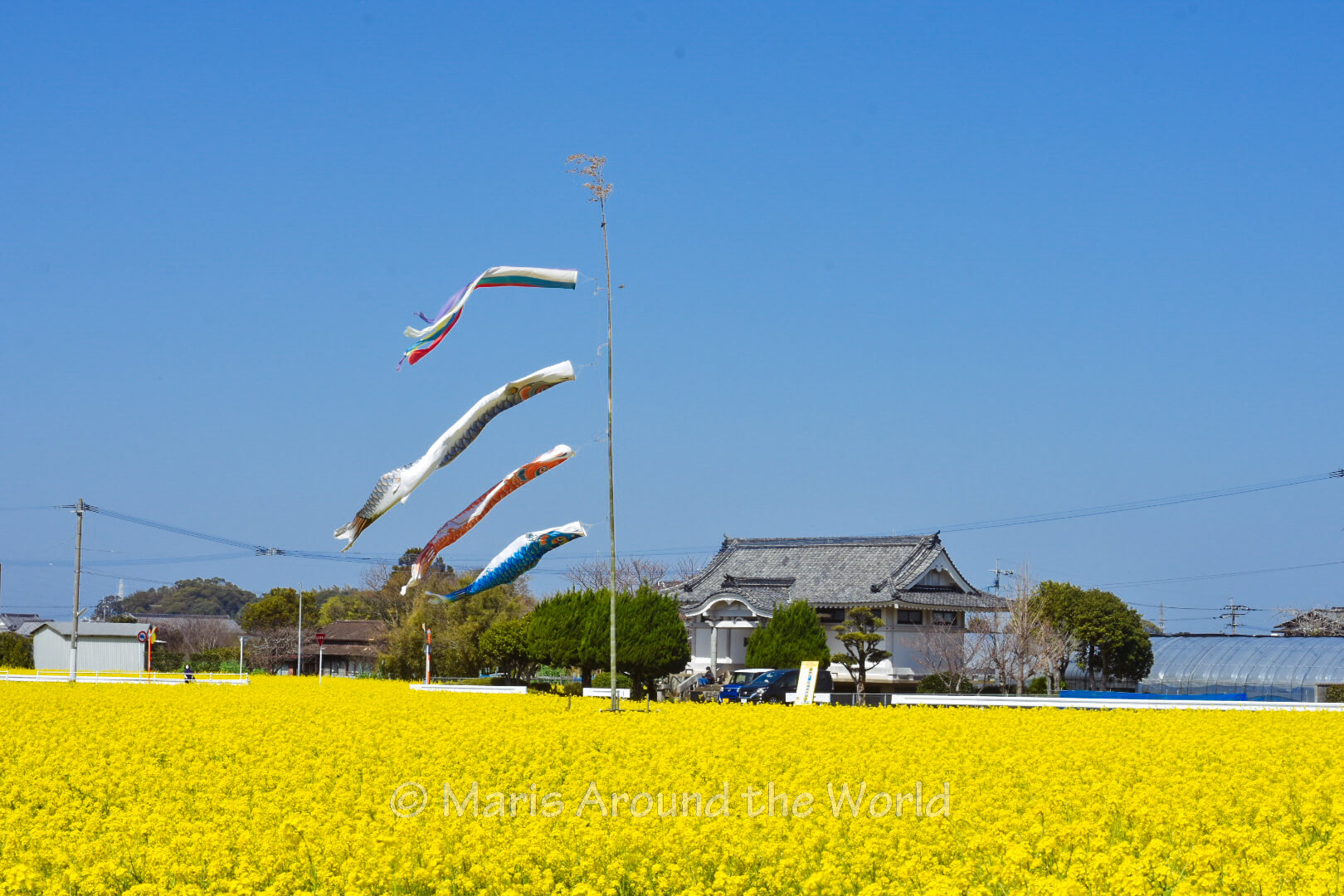What is Nanohana?
When I say “springtime in Japan”, the first thing that probably comes to mind are cherry blossoms. While I too am a big fan of these beautiful trees (you can read here about the cherry blossoms in Fukuoka), today I’m going to introduce another special spring plant, nanohana! (菜の花)

Nanohana (also known as rapeseed or field mustard), is a bright, leafy-green vegetable that is a member of the cabbage family. Slightly bitter and with a similar taste to broccolini, this plant is often used in Japanese cooking. While nanohana plants grows over 1 meter in height, only the very tops are used in cooking. (This plant also becomes more bitter as it ages, so the best time to pick is before the bright yellow flowers have fully blossomed.)

Nanohana Field in Koga, Fukuoka
In the spring, large fields of nanohana can be found blooming all over Japan. Eager to frolic amongst the beautiful colors, I planned a trip to see some for myself. There are multiple nanohana locations around Fukuoka that you can visit, but the closest one to me was in Koga, Fukuoka. After a three mile walk, I arrived at the Koga Nanohana Field. With so many tall, blooming plants, it looked like I was surround by an ocean of yellow! As I stepped into the field (which was just off the road and open to the public), I could tune into the sound of bees buzzing around me and smell the powerful scent of blossoming flowers. (Maybe not the best place to visit if you have allergies).
I enjoyed the lovely view and took some silly photos because I couldn’t get enough of the blue sky and yellow flowers.

In the middle of the field, there were also flag poles with carp windsocks blowing in the breeze

I walked over 5 miles to see this nanohana field, but the exercise was well worth finding such a unique and picturesque location. Now I know that cherry blossoms AND nanohana are worth appreciating and visiting during Japan’s spring.
Getting There
If you don’t have a car, be prepared for a bit of a walk as this field is located quite far from the nearest station. From Koga Station, it takes about 45 minutes to cover the 2 mile trip. Though far, the path is relatively easy and takes you through peaceful streets and strawberry farms.
[googlemaps https://www.google.com/maps/embed?pb=!1m18!1m12!1m3!1d3318.227109083461!2d130.4941144146162!3d33.72894298069506!2m3!1f0!2f0!3f0!3m2!1i1024!2i768!4f13.1!3m3!1m2!1s0x35422820bfa31e09%3A0x1a687657a86e08ec!2z56215YaFIOiPnOOBruiKseWFrOWckg!5e0!3m2!1sen!2sus!4v1618580629011!5m2!1sen!2sus&w=600&h=450]
Want to learn about more things to do in Fukuoka? Check out this post: What to Do in Fukuoka – 20 Local Recs to Add To Your Itinerary
If you are interested in other Fukuoka Day Trips, be sure to check out these posts!
- Dazaifu Tenmangu– 40 minutes by train, known for the large temple, lively shopping street, and yummy baked mochi treats!
- Yanagawa– 1 hour by train, famous for unagi, canal punting, and beautiful Hina-Matsuri decorations.
- Kurume (coming soon)
- Kitakyushu (coming soon)
Where to Stay in Fukuoka
If you are looking for a place to stay in the heart of Fukuoka, here are the areas I recommend.
Near Hakata Station
Hakata Station is the main transportation hub for Fukuoka and the rest of Kyushu. Shinkansens, trains, subway lines, and buses – all connect with Hakata Station. Fukuoka Airport is also conveniently located just a 5-minute subway ride away. If convenient travel is a top priority, then booking a hotel near Hakata Station is recommended!
High-end: Miyako Hotel Hakata is located on the eastern side (Chikushi-guchi) of Hakata Station, mere minutes walk from the exit. Breakfast is served on the upper floors with a grand view of the city below. I have also had visitors stay at Nikko Hotel Fukuoka who enjoyed their stay.
Budget: APA Hotel is a large chain with many locations around Japan. The rooms are economical (aka a bit small) but have everything you need for a simple stay.
Tenjin and Daimyo
Tenjin is a bustling business district full of shops, bars, restaurants, and more. The area is super walkable and connects to Hakata Station easily via bus or train. Expect a louder and more dynamic atmosphere.
High-end: For a top-tier stay, you can’t go wrong with the recently built Ritz-Carlton that overlooks the brand-new Daimyo Garden City area.
Many hotels also line Watanabe-dori which is a large streets between Hakata Station / Canal City area and Tenjin.
Staying Outside of the City
For a truly unique stay outside of the city, I recommend Craft Inn Te in Yame. Read about what it’s like to stay at this art-themed accommodation here!
For a luxurious getaway by the sea, Itoshima is my top recommendation. This area is great for cycling, winter oyster huts, seaside cafes, hiking, and more. A great place to stay in Itoshima is the newly built seven x seven Hotel that sits right out over the water. Learn more about Itoshima in my full guide!
